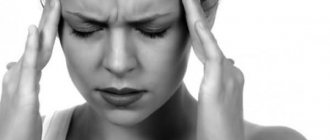General information
Synonyms for the disease are “vertebral artery syndrome”, “posterior cervical sympathetic syndrome”, which confuses the terminology.
Due to a sedentary lifestyle and long hours of work at the computer, the neck muscles are subject to significant stress. According to statistics, the most common cause of this pathology is osteochondrosis. It is diagnosed in people aged 25-45 years, and affects every third person.
Cervical migraine is not a death sentence; it is quite possible to cure it. But it is more advisable to adhere to a healthy and active lifestyle and eat right. Then this problem will bypass you.
Acute severe pain in the forehead due to injury
For normal brain function, large amounts of energy, nutrients and oxygen are needed. All this is delivered to the cells through the bloodstream.
Blood enters the brain through two paired vertebral and two internal carotid
large main arteries.
The vertebral arteries originate in the chest cavity, and then, reaching the base of the brain stem, merge into one and form the basilar artery.
Further
- anterior and posterior cerebellar arteries, which supply blood to the brainstem and cerebellum
- posterior cerebral artery, supplying blood to the occipital lobes of the brain
originates from the common carotid artery, and then, reaching the brain, divides into two branches:
- anterior cerebral artery, supplying blood to the anterior parts of the frontal lobes of the brain
- middle cerebral artery, supplying blood to the frontal, temporal and parietal lobes of the brain
Bruise of the forehead area
forehead area is this type
Cervical migraine is a type of headache. which is caused by impaired blood circulation in one or both vertebral arteries (right and left). Other names for the disease are “vertebral artery syndrome”, “Barré-Lieu syndrome”, “posterior cervical sympathetic syndrome”.
Disturbances in blood circulation through the vertebral arteries cannot provoke such serious complications as a stroke. but problems with blood circulation cause unpleasant subjective sensations: headaches accompanied by disorders of coordination, vision or hearing.
The peak of the disease occurs at the age of 30 years; in women the disease is diagnosed more often.
Diagnosis of the disease
To independently determine a cervical migraine, just press on the back of the head. At the same time, you will feel increased sensitivity of the skin in the neck area.
The lack of proper treatment for reversible migraine is fraught with increased frequency and intensification of painful attacks, and this will sooner or later lead to the disease acquiring the status of “irreversible”. Remember that headache medications only temporarily suppress symptoms and do not eliminate the cause of the disease.
If you have systematic headaches, you should consult a doctor. The specialist collects anamnesis based on complaints, examination of the medical book and the patient himself. This helps the doctor form a basic understanding of the nature of the disease. For a detailed analysis and identification of the causes of headaches, the patient is referred for hardware examinations:
- MRI (magnetic resonance imaging) or CT (computed tomography) are 2 similar technologies that differ from other methods in their high research accuracy. Allows you to examine each vertebra, vertebral arteries, and arterial canals.
- REG (rheoencephalograph) is a device that allows you to characterize the elasticity and blood supply of the vessels of the brain, the state of venous outflow, and the uniformity of blood flow to both hemispheres.
- X-ray is not the most accurate, but the most common way to determine pronounced defects and disorders of the vertebrae and cervical-brachial joint.
- Ultrasound Dopplerography (USDG) is a highly effective method for diagnosing central and peripheral vessels.
Folk remedies
Cervical migraine is a disease that has long been known to mankind and is quite insidious. It will take a very long time to treat it. One week or one month will not solve the problem. This often takes years. But be patient. There are many folk remedies for relieving attacks and treatment.
These are various herbal compresses, ointments and decoctions:
- Ointment made from lard and hops. Lubricate the back of the head with this ointment before going to bed, then wrap the neck well.
- Ointment from birch buds, mint, dandelion roots. Boil a steep broth with half a glass of boiling water, combine with butter or lard. Rub into neck.
- St. John's wort oil.
- A compress of cabbage leaves smeared with honey.
- Horseradish leaf compress. The leaves need to be preheated.
- Burdock leaf compress.
To improve blood circulation in the brain, you need to walk in the fresh air as often as possible, take at least short breaks from work, and get proper sleep and rest.
Cervical migraine is a fairly common disease, and today there are many folk remedies for its treatment that complement traditional medicine well.
To improve blood circulation during an attack, you can apply a cold compress to the forehead or temporal part, while immersing your feet in hot water.
Hot, strong and sweet tea helps relieve pain, to which experts recommend adding lemon balm, chamomile, lavender, etc. These herbs have not only analgesic, but also calming properties.
Good prevention against migraines is provided by daily neck stretching exercises.
What you need to remember (video)
- Cervical migraine is a type of migraine that is caused by impaired blood flow in the vertebral arteries.
- The causes of cervical migraine are both deformities of the vertebrae and various diseases and abnormalities of the neck.
- The headache occurs predominantly in the back of the head, but can radiate and move to different sides of the head.
- If you experience systematic attacks of cervical migraine, you should definitely consult a doctor.
- Cervical migraines can be treated with medications, massage, or physical therapy. Folk remedies include cold compresses and strong tea with soothing herbs.
Share with your friends!
Development mechanisms
To date, it has been poorly studied. There are only a few theories about this. Each of them has the right to exist.
The most common theories of migraine development
According to her, a migraine attack is caused by a sudden narrowing of intracranial vessels. As a result, it develops
(local anemia) and aura. The blood vessels in the brain then dilate, causing headaches.
It is believed that
initially have a pathology, which leads to their gluing under certain conditions.
Degenerative changes in bone and cartilaginous tissues often occur due to different types of pressure on the neck area.
As a result of the influence of all the above reasons, irritation of the nerve trunks and vertebral arteries occurs, which causes a spasm of the muscular elements in their walls and a sharp narrowing of the lumen of the arteries - a cervical migraine begins.
If any of the above pathologies are present, then the person experiences irritation of the nerve endings and vertebral arteries, resulting in muscle spasm, a sharp narrowing of the lumen of the blood vessels and the development of cervical migraine.
Symptoms of cervical migraine
The main symptom of cervical migraine is constant or paroxysmal pain in the occipital region. As the attack intensifies, a burning, throbbing pain radiates from the back of the head to the forehead, eye sockets, bridge of the nose, and ears.
In most cases, the source of pain is in one place and can move when the position of the head or neck changes. During an attack, the scalp is very irritated, and any touch, especially combing the hair, is very painful. A short-term increase in pain occurs even with not too sudden movements of the head.
A severe attack of cervical migraine can cause nausea and vomiting. In this case, dizziness does not stop even when lying down. There is a ringing or background noise in the ears, and sometimes a heartbeat can be heard. A headache is often accompanied by a change in temperature - a person begins to feel feverish, or on the contrary, he becomes cold.
In some cases, cervical migraine causes distortions in auditory and visual perception. Hearing temporarily deteriorates, vision clarity decreases, and abstract geometric images may appear before the eyes. General attentiveness decreases, and a person’s perception of the environment slows down.
Sometimes, with a cervical migraine, you feel a dry throat and a “lump” that makes it difficult to swallow, and in more rare cases, an attack can lead to loss of consciousness.
Causes
We are talking not so much about the causes of migraines themselves, but about the starting (trigger) factors that can lead to the development of the attack itself.
Groups of risk factors
- flavor enhancers that are used in seasonings, canned food, frozen foods, instant soups
- sweeteners included in carbonated drinks, juices, chewing gum
- tyramine contained in hot smoked fish, aged cheeses, salted herring, alcoholic beverages, yeast
- sodium nitrates, which are used to preserve meat products
- coffee Tea
- chocolate, citrus fruits, legumes, nuts
- high fat foods
- seafood
- pickled and smoked products
- strong odors of perfumes, cleaning products, varnishes and paints, tobacco smoke
- Lights that are too bright or flickering
- sudden change in weather conditions
- sleep disturbances (lack of sleep or long periods of sleep)
- overwork
- Irregular eating or excessive dieting
- stressful situations (acute, chronic)
- at the end of a stressful situation: after signing a contract, making a responsible speech, receiving a promotion at work
- change in the rhythm of life and time zone changes
- increased physical activity in poorly trained people (especially at the beginning of training)
- smoking
Problems with blood vessels are not associated with spinal disc disorders. Most often, these can be congenital anomalies that cause a decrease in the lumen of blood vessels or atherosclerosis. They are relatively rare, and their independent significance during the course of the disease is insignificant. Painful sensations in most cases appear due to simultaneous exposure to other causes.
All causes of cervical artery syndrome, by the nature of their origin, are divided into 2 types: vertebrogenic and non-vertebrogenic.
Vertebrogenic
Treatment
Severe one-sided headache is just one manifestation of the disease. In fact, the symptoms of the disease are quite varied and largely depend on the type of migraine.
Forms of migraine
The classic course of the disease. Occurs only in 20-25% of cases.
- with normal aura (lasts from 5 to 60 minutes)
- with a long aura (lasts from one hour to several days)
In 75-80% of patients, the disease occurs in this form.
However, sometimes the same patient experiences both types of migraine attacks, alternating with each other.
Types of auras
This is a long process that includes fighting pain, as well as taking medications that prevent its development. This enables patients to control their disease and live a full life.
How to get rid of migraine pain?
Today, treatment of migraine pain is carried out taking into account how pain affects the patient’s daily life. This is assessed using the MIDAS (Migraine Disability Assessment Scale) scale.
The scale is based on time lost due to headaches in three main areas of life:
- in study and work
- in housework and family life
- in sports and social activities
Thus, the MIDAS scale divides migraine attacks into four degrees:
The quality of life of patients practically does not deteriorate. Therefore, they rarely go to the doctor, since physical methods (cold) or traditional medicine help them.
The most commonly prescribed medications are simple painkillers (Analgin) or non-steroidal anti-inflammatory drugs (NSAIDs): Ibuprofen (preferred), Naproxen, Indomethacin. II degree.
Headache is moderate or severe, and restrictions in daily life are minor
For mild headaches, NSAIDs or combined painkillers are prescribed: Codeine, Tetralgin, Pentalgin, Solpadeine. When the headache is severe and the ability of patients to adapt to environmental conditions is impaired, triptan drugs are prescribed (Amigrenin, Sumamigren, Imigran, Naramig, Zomig and others).
III-IV degree. Severe headache with moderate or severe (IV degree) restriction in daily life. In these forms, it is advisable to immediately start with drugs from the triptan group.
However, in some cases Zaldiar is prescribed. It contains Tramadol (a strong pain reliever) and Paracetamol (a weak pain reliever with antipyretic properties).
If the attacks are severe and persistent, the patient is prescribed hormonal medications. For example, Dexamethasone.
To combat nausea and vomiting, antiemetics are used: Metoclopramide, Domperidone, Chlorpromazine and others. They are recommended to be taken 20 minutes before taking NSAIDs or a drug from the triptan group.
What are triptan drugs? They are the “gold standard” because they are designed specifically to relieve migraine pain. Their effect is most pronounced if you take the required dose at the very beginning of the attack.
Recommendations for use
- When the patient feels the onset of an attack approaching, it is necessary to take one tablet. If after two hours the pain has passed, then the patient returns to his normal life.
- If after two hours the pain has decreased, but has not gone away completely, you need to take another tablet. And during the next attack, it is recommended to take two tablets at once.
If the medicine was taken on time, but it did not help, then it is necessary to replace it.
- The first is represented by Sumatriptan. It is available in tablets (Amigrenin, Imigran and others), in the form of suppositories (Trimigren), and in the form of a spray (Imigran).
- The second is Naratriptan (Naramig) and Zolmitriptan (Zomig). They are more effective and cause fewer side effects.
It should be remembered that patients have individual sensitivity to drugs of the same group. Therefore, for each patient it is necessary to choose “your own” medicine and if it is found, then you should not experiment further.
| On a note! Drugs used to prevent an attack from developing work best when it begins. Therefore, patients are advised to always carry the medicine with them and take it as soon as the first signs appear. |
A phase 2 study of the drug Olcegepant is currently underway. When administered intravenously, it prevents cerebral vasodilation at the onset of a migraine attack. The effectiveness of the tablet form of Olcegepant is also being studied and evaluated.
In addition, research is being conducted on a drug codenamed AZ-001, which is used to treat nausea and vomiting. According to recent data, it is also effective in the fight against migraines.
The advantage of the drug is that it is used using inhalers of the “Staccato” system. The essence of how this inhaler works: the device has a built-in battery, which, when you press the piston, heats up the solid medicinal substance, turning it into an aerosol.
Next, the aerosol enters the lungs, and from there into the bloodstream. Thus, the effectiveness of the drug increases significantly, becoming equal to the intravenous route of administration.
What medications help treat migraines?
In addition to relieving migraine attacks, there is another important component in the treatment of the disease itself - preventing the development of attacks.
For this purpose, various drugs are used, including those whose instructions do not indicate their effectiveness in the treatment of migraine. The fact is that the mechanism of migraine development is not yet completely clear. Therefore, it remains inexplicable why drugs used to treat completely different diseases help with migraines.
Basically, one drug is prescribed, since the treatment is long-term, and any drug can cause side effects.
(used primarily) - beta-blockers. Although how they help prevent a migraine attack remains unclear to this day. The main drug is Propranolol.
Are used
. The basis for their use is their good effectiveness in the treatment of chronic pain. In addition, they reduce depression, which can develop in patients with a long course of the disease and frequent attacks.
In addition, antidepressants prolong the effect of painkillers and triptans. And some antidepressants themselves can reduce headaches. The most effective and safe drugs are the new generation of antidepressants: Venlafaxine (Velafax), Milnacipran (Ixel), Duloxetine (Cymbalta).
Well proven
: valportates (Depakine, Apilepsin) and Topiramate (Topamax). Moreover, studies have proven that Topiromat is the most effective. Because it reduces the frequency of attacks quite quickly - within the first month of use. In addition, it is well tolerated by patients.











